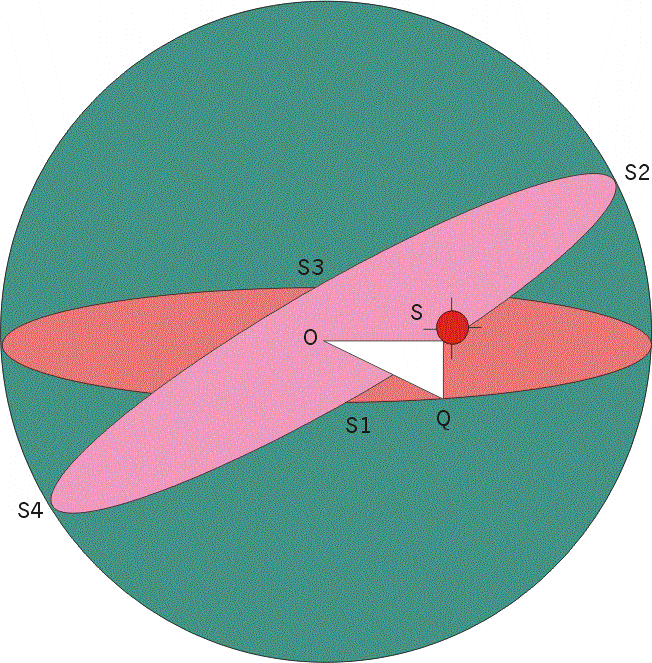
The Biggest and the Brightest
The sun, the unique star of our solar system, presents itself to the universe with its full warmth and brilliance. Our ancestor's art of observation had not failed to capture the many intrinsic patterns hidden in the beauty of the central star of our solar system.
As with any other object in the sky, let's try to understand the sun by tracing its position relative to the earth. Then we would easily be able to muse over many results that we normally take for granted. We do this using the geocentric model, in which, the earth forms the centre of our study and all other objects, and their motions are viewed relative to the earth.
In this model, the sun moves around the earth in a nearly circular path called the ecliptic, and this ecliptic is a great circle on the celestial sphere. (Note that this apparent motion of the sun is due to the earth moving around the sun. This circular path corresponds to the motion of the earth around the sun in a single year.) A curious observer would like to know about the relative position of the celestial equator and the ecliptic. The truth is that they don't lie on the same plane. Instead the ecliptic is inclined at an angle of 23 1/2 o to the celestial equator. This inclination of 23 1/2 o is called the obliquity of the ecliptic. How is this obliquity of the ecliptic going to bother us? In fact, the seasons of the earth are a direct consequence of this obliquity.
Just have a look at this figure to get a WHOLE picture of what is just said.

In the figure the pink colored region's circumference is called the ecliptic and the orange one's is called the celestial equator. The central 'O' is the earth.
As can be seen from the figure, the ecliptic touches the celestial equator at two points (S1 and S3). Geographers referred to these points as the Vernal equinox (also called spring equinox) and the Autumnal equinox. The vernal equinox (S1) occurs around March 21st of every year and the autumnal equinox occurs around September 23rd of every year. The interesting phenomenon that we observe on these two days of the year is that, the sun rises exactly in the East and sets exactly in the West. Also, the duration of the daytime is exactly 12 hours at either equinox. This is straightforward because on these two days the sun lies in the plane of the celestial equator.
But what about the position of the sun during the rest of the year? Let's trace the path of the sun, starting from the spring equinox (S1). After crossing the spring equinox (S1), the sun will be to the north of the celestial equator until the autumnal equinox (S3). Then the sun crosses the autumnal equinox (S3) before going south of the celestial equator. It will be to the south of the equator till it reaches spring equinox (S1) again.
Here are the same points put in another way.
While the sun is to the north and south of the equator, two important observations are to be made.
The seasons that any place on the earth experiences are based on the position of the sun relative to these points (S1, S2, S3, S4). The western and Indian geographers define seasons differently . But, whatever be the way of defining seasons, the fact is that, the seasons are a direct consequence of the Obliquity of the ecliptic. If there were no obliquity, then we would all be enjoying equinoxes all through the year! Click to view slides on seasons and their causes.
Interestingly, these equinoxes are not fixed. Instead they move and the continuous rotation of the equinoxes in the westerly direction is called as the precession of the equinoxes. Inquisitive readers can follow the link to know more about this phenomenon. --> Precession of equinoxes.
We will wind up this session with another intriguing concept - the declination of the Sun. Have a look at the labels SOQ in the figure and then proceed.
Corresponding to the position S of the sun, a circular arc (on the surface of the celestial sphere) is drawn from the sun to the celestial equator which intersects it at Q, such that the circular arc is perpendicular to the equator. In other words, draw a perpendicular from the sun to the equatorial plane to get the point of intersection (Q’, say). The point where the extension of the line segment OQ' meets the celestial equator is Q. Just imagine how it would be drawn and then go on.
The angle corresponding to the arc SQ (i.e., <SOQ or <SOQ') is the declination of the sun. At equinoxes, the declination of the Sun is zero. At the summer solstice, it is 23 1/2 o North and at the winter solstice, it is 23 1/2 o South. During the course of a particular day, the declination doesn't change much and is normally considered to be constant.